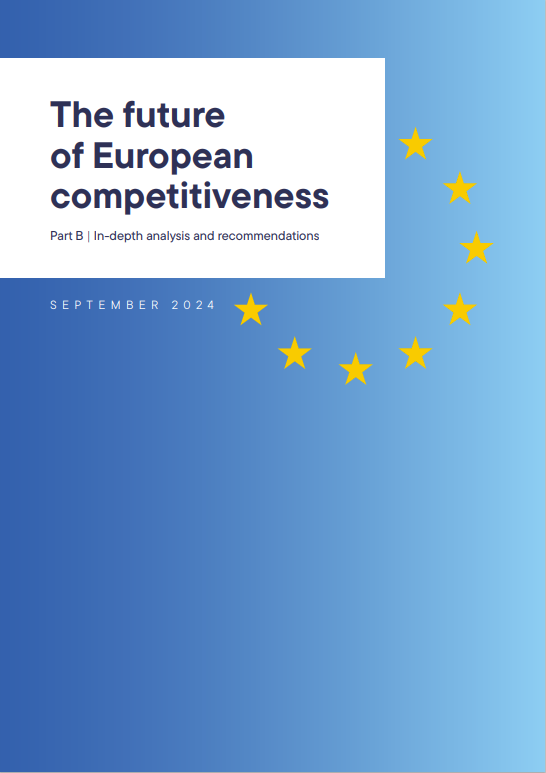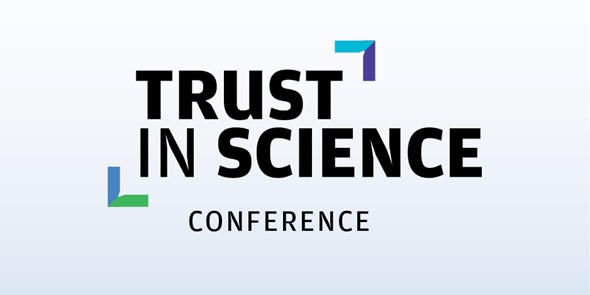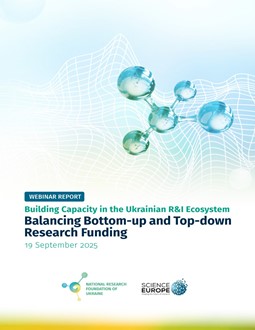
-
Share on
Research Funding at the Forefront of EU Strategy in the Draghi Report
Mario Draghi’s report, “The Future of European Competitiveness,” calls for the EU to boost research and innovation spending to EUR 750-800 billion annually to compete with the US and China. It emphasises meeting the 3% GDP target for R&D and highlights the need for transparent, inclusive funding processes. Science Europe supports these recommendations, stressing the importance of increased R&D funding to ensure the EU’s competitiveness and innovation capacity.
“Failure to meet the 3% target for R&D expenditure set by EU leaders over two decades ago is a fundamental reason why the EU lags behind the US and China.”
- Mario Draghi
Mario Draghi’s Report, “The future of European competitiveness – A competitiveness strategy for Europe”, as the title suggests, pitches the EU’s main challenge in the coming decade will be remaining competitive with both the US and China. The solution – Draghi contends – is to supercharge productivity and growth through an increase in annual spending estimated at EUR 750-800 billion. Overall fiscal viability aside, Draghi correctly frames research as a critical area for increased support to best ensure the EU’s competitiveness and innovation capacity, noting that the EU’s broad “failure to meet the 3% target for R&D expenditure set by EU leaders over two decades ago is a fundamental reason why the EU lags behind the US and China.” Like many in the European Research Community, Science Europe welcomes the comprehensive analysis and recommendations related to research policy and funding presented in the report. Science Europe agrees with the assessment of the critical role of research, and has consistently called for increasing public and private R&D expenditure to at least 3% of GDP, as part of the Vote4Science campaign and Research Matters campaign in the build up to the Parliamentary Elections most recently.
While there have been many calls for increased R&I investment, including from President von der Leyen herself, particularly appreciated is Mario Draghi’s specific R&I funding recommendations to commit to the already widely endorsed calls for 3% GDP spending at a member state level, as well as increasing the budget for the next Framework Programme (FP10) to €200 billion at the European level, as well as the related call to double the support for fundamental research through the European Research Council (ERC). These significant increases are necessary to meet the ambitious objectives of the European Union in ensuring the global competitiveness of its research sector. Yet, in support of Mario Draghi’s assertion that funding deficits have been a “fundamental reason” the EU is failing to remain competitive, Science Europe has highlighted the current programme’s inability to fund 71% of the high-quality proposals received due to budget shortages, as well as the expected continuation of this trend should current budgeting expectations for FP10 play out.
When reviewing Draghi’s further recommendations centred on competitiveness, what is potentially more difficult – yet necessary – is to ensure a sound and inclusive process for establishing well-balanced priorities for both EU and national R&I funding programmes. This process must be conducted in dialogue with research organisations and other stakeholders, maintaining a long-term approach to not only building up the EU's competitiveness, but also with those related to addressing climate change, protecting the environment, and maintaining and enhancing citizens’ well-being and prosperity. Hence, whilst increasing funding to support industrial competitiveness and decarbonisation is essential, it is important this does not come at the expense of financing research which supports less economically centred values and priorities that stand as defining pillars of the EU.
Science Europe acknowledges the Draghi’s recognition of the challenges many applicants face in navigating Horizon Europe. As Science Europe has previously stated as part of its ‘10 Key Messages for the 10th EU Framework Programme for Research and Innovation (FP10)’, "it is not always easy for applicants to understand the policy or political background that guide the development of the calls for proposals". This issue is further compounded by the complexity of the application process, which can be a significant barrier for many researchers. Science Europe has therefore emphasised the importance of transparent and open communication regarding eligibility rules and the rationale behind specific calls to protect Horizon Europe’s global attractiveness, and this consideration should doubtless be taken forward for FP10 as the report suggests.
While it is commendable that the report sees decarbonisation as one of the cornerstones of competitiveness and highlights the importance of equity and social inclusion, the EU needs a systemic and science-based approach to tackling societal challenges. The EU's green and digital transition will only be economically successful if it also respects planetary boundaries and leaves no one behind. For this reason, while it is absolutely true that the EU needs to invest more in its industrial competitiveness, it is equally important to support fundamental and targeted research that addresses other societal and global challenges and creates a fertile ground for innovations across a broad spectrum of domains, not merely technological or industrial.
On this note, a regrettable omission from the report regarding European research funding relates to ensuring better protections to prevent the diversion of funding from FP10, following the unfortunate, recurrent habit of cutting into the budget of the €95.5 billion Horizon Europe research programme to find money for other political priorities. This was highlighted in one of three calls in the Research Matters Open Letter to “protect [FP10] by ringfencing the budget”, which whilst signed by many research and higher education organisations earlier this year, remains absent from the report.
On the matter on ‘dual-use’ research, Science Europe has previously stressed the need to maintain distinct boundaries as it pertains to funding allocation for R&D on dual-use technologies for both civil and defence applications. Observing in a position statement in response to European Commission's white paper on R&D on Dual-Use Technologies that, “Civil research should continue to be clearly distinguished from defence research, as laid down in Horizon Europe’s legal provisions (Articles 5 and 7(1)). Investments in ‘peace’ research should also be promoted. ‘Dual-use’ research should not be tackled in isolation from other equally important areas of research, such as on diplomacy and peace.” Yet, as part of the recommendations for European defence, Draghi’s report proposes to “concentrate efforts and resources on common EU R&D/R&T defence initiatives and maximise technological spillover between civil and defence innovation cycles.”
In short, Mario Draghi’s report underscores what has been Europe’s shortfall for a decade, the critical need to enhance its competitiveness against global powers like the US and China. Whilst Draghi’s total of 750-800 billion euros a year extra in spending is unlikely, what is outlined for research and innovation must be enacted to reach long-standing R&D expenditure targets. The report’s recommendations, including committing to 3% GDP spending on R&D and significantly boosting the budget for the next Framework Programme (FP10), should be considered the bare minimum to achieving Draghi’s broader goals.
Science Europe supports these recommendations, whilst emphasising the importance of transparent and inclusive processes in setting funding priorities. A balanced approach that addresses industrial competitiveness while also supporting research in areas like climate change, environmental protection, and social well-being will be the key to Europe’s relevance on a global stage. Ultimately, Draghi’s report provides a comprehensive strategy for bolstering the EU’s competitiveness, but as many now begin to talk about implementing its recommendations, the commitment of all stakeholders to a long-term vision that balances economic, environmental, and social priorities should remain in focus.















